#the norteño experience
Explore tagged Tumblr posts
Text
It would be so funny if Leo and Calypso stay on the way station, feel like Jo and Emmie are their mothers and at some point they break up and become like something similar to siblings. It would be the norteño experience for rule ever. And of course Lit and Georgie would make fun of them for the rest of their life.
#idk if on other countries exist this too#but it's something that in Argentina happens(?#at least on cordoba#when you were younger and you liked your cousin for like a month#the norteño experience#I don't know anyone who hasn't experienced it#children skill issue#caleo#riordanverse#pjo hoo toa#the waystation#leo valdez#calypso pjo#lityerses#Georgina
15 notes
·
View notes
Note
I saw your Hobie x latina going going to the club para perrear and I loved it😭🤞🏼😩
BUT
Imagine Hobie going to a cantina with a mexican reader and just drink and hear corridos tristes (el video del vato que dice "porque que te quiero" y le meten el micrófono a la boca😭💀) or rather going to a cantina goes to her house and her family is making carne asada and drinking beer and there's literally a band in the party (soy norteña perdoname😭) and he is like "this food is bussing bussing" because he is British and their food is just "no good💖". At first he is nervous like he doesn't know what to do and at the end he is somehow riding a horse or he is playing with the band, he just loves it, the vibe and the food
(Love how you write 😭💖)
Hobie Brown meeting latina!reader's family <3

Masterlist <3
Ay hermana, soy chilanga we don't have horses up in this bitch😭 I tried to make it more general like Bee meeting your tías and primos but def adding the whole carne asada deal. (For my non-mexican readers, we call people from the city "chilangos" and northern people "norteños" and while we're from the same country, our experiences can be very different!). Also, tysm my dear, hope u like<3
-First off
-Giggling and kicking my feet 🤭
-Bro was persistent in meeting your family, and while you weren't exactly reluctant, you did have to warn him
-"Why not!? I want to meet your uncle Luis or- or Saúl!" He exclaims, recalling the stories you've told about your family members. "I'm not saying no, mi amor. I-It's just-" "What?" He grins, knowing you don't really have a solid argument. He kisses your pout and walks over to your room to get ready as you sigh, defeated by your pretty once more.
-Of course you wanted Bee to meet your family! But we all know how it can get at those big family gathering.
-One thing was meeting your parents, (which went by spectacularly, by the way) but him hanging out with your older tíos and younger primos was a whole other deal
-They aren't bad people, you love them dearly. It was the soft (hard and relentless) teasing (borderline bullying) you were worried about.
-It was easy to understand their humor when you grew up with heavy jokes, but Hobie would be new to all this. Plus, he was the first official boyfriend you'd introduce to the family! They were protective and honestly not afraid to show it.
-"Buenas tardes, Hobie Brown. Mucho gusto" you say slowly as you're both on the way to your tío's house, he repeats after you with a horrible accent. "Roll your r's!" You giggle, looking at him intently while softly showing him how to pronounce.
-He's really trying for you bestie </3
-Yeah he went blank after your aunt opened the door and dismissed his polite handshake with a bone-crushing hug.
-"Ay mija! He's so tall, I can barely hug him right. Pásenle, pásenle, Luis is in the garden with the kids. Welcome Hobie!"
-Bee just smiles and it widens when a horde of kids comes running down the hall and bolt towards you, saying hello to their favorite aunt and the strange bato she brought along.
-"Tía Y/N/N who is this?" Luisa (the youngest) asks, eyeing Hobie up and down with the sass of an old lady, making him suppress a laugh "Es tu novio?" now questions one of the boys, looking up at him amazed. "Hello brats" he smirks, high-fiving each and every one of your nieces and nephews excitedly.
-"You didn't tell me you were a tía already..." "Some of them will be by the age of sixteen, so I'm no rare event."
-Hobie is hard to lose on a crowd; all spikes, leather, chunky boots, and piercings
-Your nephews are thrilled.
-Asking all around about what his pins mean, if he finds it hard to walk with those boots, if he's not too hot with his jacket... you know, the type of questions kids ask.
-You laugh at him, trying to answer one question at a time patiently, and walk over to the table outside where your tíos, tías, primos, primas, cuñadas and some sobrinos were.
-"Y el novio mija?" Asks one of your tíos, already in a deffensive tone "He's inside con los niños, tío. Ahorita viene" you smile and promptly, Hobie walks through the door after the kids.
-The smokey scent of the carne asada filled his nostrils as soon as he walked outside, widening his eyes at how good it smelled. You walk over to him, grabbing his arm and smiling widely at your family
-"Les presento a Hobie, mi novio" you beam and your tíos can tell he truly makes you happy. "Yo no te di permiso, Y/N" one of them jokes, making everyone laugh and Bee follows after you translate for him.
-And he didn't like it but he really cared about their opinions
-He didn't give a single fuck of what other people had to say, but this was your family!!! He knew he was close and for the first time, strived for perfection
-The next few minutes were him trying really hard to memorize all the names, having a hard time pronouncing your aunt Rocio and Rosa's names.
-Everyone laughed at his attempts
-You sit between everyone at the large table, one of your tíos approaching you as you're too busy catching up with one of your cousins. Bee squeezes your hand to catch your attention, but you don't turn back to look at him, instead just squeeze back.
-He nervously places his hand out, and contrary to before, your uncle welcomes it. "Buenas tardes, Hobie" (oubi😭con acento mexa) "Buenas tardes, señor". God, did he rehearse that on the way...
-Your uncle seemed to appreciate him at least trying to talk to him in your mother tongue. He gave him kind of a smile and asked "Wanna help me with the asador over there?"
-Oh this was a test
-"Sure thing" he nods confidently even though he's shitting himself at the moment
-When he saw the carne asada let me tell you
-His mouth watered, heart eyes all over and he swore he was about to do that floating thing he's seen spider pig do
-Your tío taught him how to turn the steaks at the right time, after some aceite jumped and burnt him a bit :( your uncle could tell he was trying hard so he took it easy on him
-Personally? You fell in love all over again when he contained his tears the best he could at the smell and spice of the chiles floating so close to his nose <3
-You slapped his ass playfully when serving the food and he just smirked as your uncle side eyed you HARD
-“Bloody hell this shit is fucking amazing babe!” He almost moans when he bites into the taco of asada you made for him
-Your family might or might not know english but they know how bad words sound lmao
-They couldn’t blame him tho, not after he proved to love asada as much as them with the eight tacos he ate ☹️💕
-Him playing with the babies of your family bro :(
-He's so good with kids too
-I'm talking playing with them, having full conversations no matter how silly they got, following their train of thought and even making sure they weren't up to some stupid shit
-Girl, if you don't rail him stupid after that-
-He got along with your older cousins too!!! After all, they shared a similar taste in music and films so there was plenty to talk about
-Your tías chismeando with you about how handsome he is
-Let’s wrap it up, I got carried away and this is too damn long 😭
-He’s talking to one of your tías when the banda arrived at around 9 p.m
-My man is so confused please help him
-His spidey sense went off before the whole fucking commotion started lmao
-When he realized it was a live group playing and singing traditional music he lost his shit
-Asked you all about it!!! “What is that piano thing!?”, “What is he singing about?”, “Can I learn how to play that?”<3
-Eventually (and with no alcohol needed since he refused to risk doing some stupid shit with your family) he ended up dancing with your tía, her patiently teaching him how to move
-He had a hard time with his big ass boots but somehow managed!!
-Hobie was so happy when you went home ☹️ almost asking when you could come back and if you could cook some carne asada the same way your uncle (his best friend, he called him) did
-“Yo te amo mi amor” He smiled big, kissing you softly before falling asleep “Thanks for letting me meet your family… meant a whole lot y’know?” “‘Course corazón, seeing you there with everyone filled my heart with a joy I have rarely experienced”
-And with that you fell asleep, Hobie dreamt of asada and banda<3
#atsv hobie#hobie brown x latina!reader#hobie brown fanfiction#hobie brown x f!reader#hobie brown x hispanic reader#hobie brown angst#hobie brown#hobie brown x y/n#hobie brown x you#hobie x y/n#hobie brown x reader#hobie brown smut#hobie brown fluff#hobie brown one shot#hobie brainrot#he’s my baby boy#spider man: across the spider verse#spider man across the spider verse#spiderman headcanon#hobie brown headcanons#hobie brown fanart
256 notes
·
View notes
Note
So cowboys were actually mostly poc, queer people and gnc people. This is because cow herding was not an easy job, so people who were ostracized in society found it easier to get work their, for a less nuanced version of it (because I'm on 8%). There was a particularly memorable story for me about a ftm trans midwife, who would ask women "are you comf?" And was generally very kind and understanding. After his death, it was found out that he was trans, and a lot of his memory was tarnished. His closet friend, a woman said afterwards about him "Poor dear. I hope he's comf." And it makes me want to cry.
Oh vaqueros! My family are vaqueros! They were called vaqueros, which can be very loosely translated into cow herder/man, which is how we got the English word for cowboy! You're correct in that vaqueros were primarily poc and/or queer, but the notion that they were made up of ostracized people is more for the American cowboys, as vaqueros in Mexican and Native cultures were highly respected by their people! Usually, vaqueros were norteños (Northern Mexican men), Mexican indigenous, American indigenous, black, or mixed men! They were hired to cattle ranchers often to herd cattle, and known for reata, which is the art of lassoing to catch animals (I'm not sure how to explain better in English sorry).
There were many competitions for vaqueros to show off their lasso skills, my stepdad actually participates in local shows/competitions! He's won a few too it's super cool! In the modern area, cowboys as we know them from the American side are usually wealthier ranchers. They tend to own a lot of land and animals, and are usually cornerstones of their communities For Mexican and Indigenous vaqueros, in my experience, they're usually the common person and not exclusive to wealthier families. Many families grow up with bringing their kids into the lifestyle, and are usually small business owners. They get hired on to do the 'dirtier' work of caring for the horses' and cattle wellbeing, such as trimming and shoeing their hooves, branding, and training younger foals.
For the ones that were ostracized from society, though, you're correct that it was sometimes a sad life for them. It was often the only way of living for queer people in the southwest, as they were limited in what they could do to live sustainably. Unfortunately, cowboys and vaqueros were looked down on my Americans taking over the west, and it wasn't uncommon for even the most kind cowboys' names to be tarnished. Because the American school system is very limited (being nice about it) in what they teach, and have looked down on cowboys and vaqueros because they were poc and/or queer, even though they were greatly respected by their own communities.
The irony is that American cowboys are seen as one of the highest examples of masculinity at the same time. It's disappointing, because there's so much history and culture within old vaqueros that is incredibly interesting! I'm particularly disappointed with the lack of information on queer vaqueros, but I know there's more research going on about them at the moment! Hopefully we'll have more history revealed soon!
28 notes
·
View notes
Text
Xaderphiromantic and xaderphisexual: when you're in love with your cousin
I think we should have a word for this, but it seems no one has coined one yet.
When I started to think I was in love with my cousin, I wanted to read about romantic relationships between cousins in an attempt to convince myself that this was wrong. However, I found the Wikipedia article on cousin marriage, and the more I read about it, the more I became convinced that it was a perfectly valid feeling.
I live in a country where marriage between first cousins is legal, but it is heavily stigmatized. They make fun of people who talk romantically about their cousins, saying that they are "norteños" (from the North, a stereotype just like the Alabama jokes in the U.S.).
It seems hard to find an online community of people who are attracted to their cousin, other than the now-defunct website CousinCouples.com (which had some really good info and tips for sharing your feelings with a cousin), unless we have a concise word to describe this feeling.
Although "genetic sexual attraction" may be related to this, it is too general, and "cousincest" just sounds wrong (if you google this word, you get many NSFW results). Love between cousins is not incest, and it is widely accepted in many cultures.
So, using the Modern Greek word ξαδέρφι (xaderfi, a generic term for all cousins), I came up with xaderphiromantic for someone who experiences romantic attraction (exclusive or not) to their cousin. Similarly, xaderphisexual is someone who is sexually attracted to a cousin.
18 notes
·
View notes
Note
☆ൠ cousins abel and rosa
ANON TE QUIERO THANK YOU FOR THIS ASK EVEN THO I ANSWERED THIS LITERALLY YEARS LATE AAAA
From this headcanon meme!
☆ Happy headcanons!
Having music in the household is obviously a happy memory. Now that music is in the house, Abel and Rosa are now free to explore the once-forbidden realm.
Abel found joy in learning the accordion after Abuelito showed him Norteño music, and VERY quickly realized that he had a beautiful and rich voice thanks to some impromptu lessons from Miguel. He might or might not had used these skills to woo Doña Castillo's granddaughter, much to the her delight (and Miguel's dismay, but Abel promised to take over with shoe-shining for a day so it was worth it). The shoes technique was good and it did work in getting him closer to her, but nothing made his heart soar with delight than when Valéria sang along with him from her balcony before coming down to kiss him. He would look back to that day and wondered whether that was what Papá Héctor felt whenever he would sing and play music for Mamá Imelda.
Rosa also found joy in music, but for her it was the violin, harmonica, and dancing. Her discovering Olga Breeskin Torres, Elena Makhnev, and Máiréad Nesbitt greatly inspired her to learn how to play the violin and dance at the same time. Not wanting to stick to just one specific genre, however, she channeled her inner Óscar y Felipe and experimented with different genres and came up with her own unique style.
ൠ Random headcanons!
Abel is surprisingly rather protective of his younger siblings and cousin, despite his goofy personality and sweet nature. He IS Berto Rivera's son, after allーa lot of his papá's protective nature is passed down to him. He once even got into a fight when he was eight because his family's name was made fun of. He has mellowed quite a bit as he grows up but when push comes to shove he won't hesitate to throw his footwear at his target or fly in a punch or two to any cabrón deserving of it (though he would much rather not). He is also very similar to Papá Julio and Tía Rosita in such a way.
Rosa, on the other hand, isn't the most random person in the familyーthe perfect mix of Mamá Imelda's stubborn nature and self-efficiency, Tía Victoria's intelligence and sass, and Carmen's kindness. Outside of her unexpected love for chapulines and her infatuation with the boy next door named Marco, her no-nonsense and sassy nature doesn't make too much room for randomness. Nearly everything is well-calculated in Rosa Rivera's life, as to be expected from the future matriarch of the Rivera family once she is of age.
14 notes
·
View notes
Text
Host Your Dream Event with El Gordo’s Catering Services in Union

Planning an unforgettable event starts with exceptional food. At El Gordo Peruvian Eatery, we understand the power of delicious cuisine in bringing people together and creating memorable experiences. With our catering services in Union, NJ, we bring the vibrant flavors of Peru straight to your special occasions. Whether it’s a wedding, birthday celebration, corporate gathering, or a family reunion, El Gordo is here to elevate your event with our expertly crafted dishes.
Authentic Peruvian Cuisine Delivered to Your Doorstep
El Gordo’s catering services are built on the foundation of authentic Peruvian culinary traditions. Our menu features a rich array of dishes that highlight the diverse and flavorful heritage of Peru. From the savory spices of Pollo a la Brasa (our signature rotisserie chicken) to the comforting flavors of Arroz con Pollo and the tangy allure of Papa Rellena, every dish is meticulously prepared to delight your guests.
With El Gordo, you don’t have to settle for generic catering options. Instead, treat your guests to a culinary journey through Peru, right here in Union.
Convenient and Flexible Catering Options
We know that hosting an event comes with its fair share of logistics and planning. To make things easier for you, El Gordo offers flexible catering services designed to fit your needs. You can opt to:
Pick-Up Your Order: Conveniently collect your catering order from our Union location and bring it straight to your venue.
Get It Delivered: We’ll deliver freshly prepared dishes to your doorstep, ensuring they arrive hot and ready to serve.
While we do not provide event setup or management, our focus remains on delivering top-notch Peruvian cuisine that will be the highlight of your event.
Perfect for Any Occasion
El Gordo’s catering services are versatile and suitable for a variety of events. No matter the size or type of gathering, our team works with you to craft a menu that suits your occasion.
Here are just a few events we cater to in Union:
Weddings: Celebrate your big day with an array of dishes that reflect your unique taste.
Corporate Events: Impress colleagues and clients with our flavorful, high-quality Peruvian offerings.
Birthdays and Anniversaries: Make your milestones extra special with dishes that your guests will rave about.
Family Reunions: Bring your loved ones together over a shared love for great food.
Community Gatherings: Infuse cultural celebrations with the vibrant tastes of Peru.
Signature Dishes That Steal the Show
Our catering menu features crowd-pleasing favorites that guarantee to impress. Some of our most popular dishes include:
Pollo a la Brasa: Juicy, flavorful rotisserie chicken seasoned with authentic Peruvian spices.
Papa Rellena: Crispy mashed potato stuffed with savory fillings for a delightful appetizer.
Seco Norteño: A traditional lamb stew that’s rich, hearty, and perfect for formal events.
Chaufa de Mariscos: A seafood fried rice infused with bold Peruvian flavors.
Pair these with our traditional beverages, such as Chicha Morada (a refreshing purple corn drink) or Inca Kola, to offer your guests a true taste of Peru.
Why Choose El Gordo for Your Catering Needs?
When you choose El Gordo Peruvian Eatery for your catering services, you’re not just getting food—you’re getting an experience. Here’s why we’re the preferred choice in Union, NJ:
Authenticity: Our dishes are crafted using traditional Peruvian recipes, ensuring every bite is bursting with genuine flavor.
Quality Ingredients: We use only the freshest, highest-quality ingredients to prepare our meals.
Customization: Our team works with you to create a menu that fits your event and your guests’ preferences.
Reliability: Whether you pick up your order or opt for delivery, we ensure everything is prepared on time and to perfection.
Plan Your Dream Event with El Gordo
Hosting an event in Union doesn’t have to be stressful. With El Gordo’s catering services, you can focus on enjoying your special day while we handle the food. Our team is dedicated to providing exceptional cuisine that leaves a lasting impression on your guests.
Let El Gordo Peruvian Eatery be part of your next celebration. Whether it’s an intimate gathering or a grand occasion, our catering services are here to make your event extraordinary.
Contact us today to place your catering order and bring the rich, vibrant flavors of Peru to your table. At El Gordo, we’re more than just food—we’re a celebration of culture, taste, and together
0 notes
Text
[ad_1] The bajo quinto is extra than simply an instrument; it’s a vibrant thread woven into the material of regional Mexican music. With its unmistakable sound, this 10-string guitar-like instrument captures hearts and transports listeners to vigorous fiestas and intimate gatherings alike. Whether or not you’re drawn in by its wealthy tones or fascinated by its cultural roots, mastering the bajo quintos opens up a world stuffed with rhythm and melody. When you’re desirous to learn to strum your manner by conventional songs or modern hits, you’ve come to the proper place! Let’s dive into the enchanting world of the bajo quintos collectively. Historical past and Cultural Significance of the Bajo Quinto The bajo quinto, a string instrument with deep roots in Mexican music, has develop into synonymous with the sounds of norteño and conjunto genres. Originating from the Spanish guitarra de cinco órdenes, it was tailored by Mexican musicians and gained recognition in border areas. This instrument’s distinctive sound embodies the spirit of conventional celebrations. It accompanies festive gatherings and is integral to storytelling by music. The bajo quintos connects generations, bridging cultural divides inside communities. As an emblem of regional pleasure, many musicians use it to precise their heritage. Expert gamers usually showcase improvisation strategies that mirror private type whereas honoring custom. Its presence will be felt not solely in rural areas but in addition in city facilities the place people music thrives. The bajo quintos continues to play a significant position in preserving cultural id whereas evolving alongside fashionable musical influences. Important Methods for Enjoying the Bajo Quinto To grasp the bajo quinto, begin with correct finger positioning. Your left hand ought to curve naturally across the neck. Maintain your fingers near the fretboard for swift transitions. Subsequent is strumming approach. Use a mixture of thumb and fingers to create a wealthy sound. Experiment with completely different pressures; mild strokes provide subtlety, whereas agency ones convey out quantity. Hear carefully to the rhythm as you play. The bajo quintos usually drives conventional Mexican music ahead, so staying in sync is crucial. Observe taking part in together with recordings to develop your timing. Don’t overlook palm muting—a way that provides texture and dynamics to your taking part in. Barely mute strings along with your palm whereas placing them for an intriguing impact. Discover chord inversions and alternate voicings. This expands your musical palette and retains issues contemporary as you be taught new songs or kinds on this lovely instrument. Strumming Patterns and Chord Progressions Strumming patterns are the guts of taking part in the bajo quinto. They set the temper and rhythm, making your music come alive. Experiment with completely different strokes to search out what resonates with you. Begin easy. A gentle down-up strum provides a stable basis. As you acquire confidence, introduce syncopation or accent sure beats for aptitude. The clave rhythm usually present in conventional Mexican music also can information your strumming decisions. Chord progressions on the bajo quinto sometimes revolve round main and minor chords, however don’t shrink back from adventurous mixtures. Strive mixing widespread sequences like G-C-D with extra complicated choices to maintain listeners engaged. Listening to seasoned gamers will encourage contemporary concepts for each strumming and chords. Take note of their distinctive kinds—there’s all the time one thing new to be taught that may elevate your individual approach! Suggestions for Enhancing Your Bajo Quinto Abilities Observe often. Consistency is significant when studying the bajo quinto. Put aside time every day, even when it’s simply 20 minutes. Focus in your finger positioning. Correct placement can considerably improve sound hi
gh quality and velocity in taking part in. Experiment with completely different grips to search out what feels greatest for you. File your self taking part in. Listening again lets you establish areas needing enchancment that might not be apparent whilst you’re centered on strumming. Be a part of a neighborhood of gamers, whether or not on-line or domestically. Participating with others will expose you to new strategies and kinds that may encourage your individual taking part in. Don’t shrink back from experimenting with numerous genres of music. The flexibility of the bajo quinto shines in lots of settings, so exploring completely different rhythms expands your talent set. Don’t rush the educational course of; take pleasure in each word because it comes! Embrace errors—they’re stepping stones towards mastery. Well-known Musicians Who Play the Bajo Quinto The bajo quinto has discovered its manner into the hearts of many musicians, including a wealthy texture to varied music genres. One notable artist is Javier Solis, whose emotive singing and poignant melodies have made him an icon in Mexican music. The bajo quinto enhances his songs with deep resonant tones. One other noteworthy participant is Flaco Jiménez. A grasp of conjunto and Tejano music, he effortlessly blends conventional sounds with fashionable aptitude. His mastery over the instrument showcases its versatility. Then there’s Los Tigres del Norte, a legendary band identified for his or her storytelling by music. Their use of the bajo quinto helps convey highly effective narratives that resonate extensively throughout audiences. These musicians spotlight how integral the bajo quinto is to creating memorable performances and protecting cultural traditions alive. Their contributions proceed to encourage aspiring gamers in every single place. Conclusion: The bajo quinto is extra than simply an instrument; it’s a vibrant a part of cultural expression. Its wealthy tones resonate by numerous genres, including depth and character to music. As you discover this lovely stringed instrument, you’ll discover that mastering it opens doorways to creativity. Every strum can evoke feelings, inform tales, and join folks throughout generations. Whether or not you’re aiming for technical proficiency or just having fun with the journey, there’s all the time one thing new to find. The world of the bajo quinto is huge and welcoming. Embrace the problem of studying strategies and patterns. With time, persistence, and follow, your expertise will flourish. FAQ’s What's a bajo quinto? The bajo quinto is a stringed instrument resembling a guitar however sometimes has 5 strings. It performs a significant position in conventional Mexican music, particularly in genres like norteño and conjunto. Is the bajo quinto laborious to be taught? Like several musical instrument, mastering the bajo quinto takes time and follow. Learners could discover it difficult at first, however with dedication and good sources, you’ll progress shortly. What kinds of music can I play on the bajo quinto? Whereas it’s primarily related to Mexican people music, you may experiment with numerous genres corresponding to nation and even rock. The probabilities are limitless! The publish Strumming the Strings: Mastering Methods on the bajo quinto appeared first on Vamonde. [ad_2] Supply hyperlink
0 notes
Text
First Week of April: Top 7 Live Music Events

Get ready for an exhilarating week of live music filled with a diverse array of musical talent spanning genres and styles. From the dynamic energy of alternative rock with Nico Vega to the soulful beats of Black Coffee’s house music, there’s something for every music lover to enjoy.
Nico Vega
Nico Vega is an American alternative rock band formed in 2005 in Los Angeles, California. Fronted by lead vocalist Aja Volkman, Nico Vega gained popularity with their dynamic live music and powerful vocals. Their song “Beast” gained widespread attention after being featured in the video game “BioShock Infinite.
When: Wednesday 03 April 2024
Where: The Moroccan Lounge, Los Angeles (LA), CA, US
Ticket: Price: US $20.00
Time: Doors open: 18:30
Nicki Minaj
Nicki Minaj is a Trinidadian-American rapper, singer, and songwriter known for her bold persona, clever wordplay, and versatile musical style. Rising to fame in the late 2000s, Minaj has become one of the most influential figures in hip-hop and pop music.
When: Thursday 04 April 2024
Where: Barclays Center, Brooklyn, NY, US
Ticket: Price: US $59.50 – US $299.50
Time: Doors open: 20:00
Max Cooper
Max is a British electronic music producer and DJ known for his innovative approach to techno and electronica. Her show at the Barbican Centre in London promises to be a sonic journey into the depths of experimental electronic live music.
When: Friday 05 April 2024
Where: Barbican Centre, London, UK
Ticket: Price: £27.50
Time: Doors open: 20:00
Black Coffee
Black Coffee is a South African DJ and record producer renowned for his soulful house music sound and infectious beats. His show at Frank H. Ogawa Plaza in Oakland, CA, offers a chance to experience the pulsating energy of his live DJ set.
When: Saturday 06 April 2024
Where: Frank H. Ogawa Plaza, Oakland, CA, US
Ticket: Price: US $20.00 – US $249.50
Time: Doors open: 15:00
Conjunto Primavera
Conjunto Primavera is a Mexican Norteño band known for their romantic ballads and traditional regional Mexican music. With their heartfelt lyrics and soulful melodies, Conjunto Primavera has become a beloved fixture in the Mexican music scene, appealing to audiences of all ages.
When: Sunday 07 April 2024
Where: Vaqueros Nightclub, Los Angeles (LA), CA, US
Ticket: Price: US $30.00
Time: Doors open: 21:00
Olivia Rodrigo
Olivia Rodrigo is an American singer-songwriter and actress who rose to fame with her debut single “Driver’s License.” With influences ranging from indie rock to pop-punk, Rodrigo’s music explores themes of love, heartbreak, and self-discovery.
When: Monday 08 April 2024
Where: Madison Square Garden, New York (NYC), NY, US
Ticket: Price: US $20.00 – US $199.50
Time: Doors open: 19:30
Judith Hill
Judith Hill is an American singer-songwriter known for her powerful vocals and eclectic musical style. Her music blends elements of soul, funk, and pop, showcasing her incredible vocal range and emotive delivery.
When: Tuesday 09 April 2024
Where: Mercury Lounge, New York (NYC), NY, US
Ticket: Price: US $32.80
Time: Doors open: 18:00
0 notes
Text
Much needed vent about what happened yesterday/disregard I just have no one to talk to so I might as well write it here:
My brother’s killer made parole yesterday. We had a long day and it’s so fucked because he was lying. On the autopsy report of my brother there was no sign of struggle and he had no drugs or alcohol in his system or on him along with no weapon. We all spoke today and he fucking blamed it on his mental health and growing up environment and I’m like…..okay a lot of people go through things and I know it’s a different experience for everyone but my brother that’s no longer with us if he did the same shit he would’ve probably gotten life. Not only that but they legit had been raised in the same fucking “g-town” (barrio ghost town because Galt is a small town city where my brother was with Norteños) environment. That guy had no fucking remorse and was trying to make it sound like he did it in self defense when even the girl he was with at the time sold him out who was also a minor! Now he’s sending fucking love letters to a girl inmate and they plan to have a good life after making parole. He’s only falling back into the pattern of being abusive to all his partners and being codependent because of sociopathic behavior and wanting to feed on the emotions of others. Like who the fuck sells drugs to both fucking gangs? That’s already dangerous as it is and the only reason my brother went out was because he wanted to see some of his friends and family that was going to be there since he had just gotten out of prison. He wasn’t even wearing red. He threw away all his gang related clothes and his so called best friend who was really cuddles and sunshine with the rival (my brother left the gang life and they were out for him just like his former gang rival was) as well decided to kill him by luring him into a field and murdering him. My brother was changing for the good. He had already been clean and sober, hadn’t been out for a while, was scared to go outside, stayed home taking care of his daughter, he was always afraid that by him leaving that lifestyle they were gonna kill him and they fucking did. That fucking puto madre. And he plans to be in Lodi or Stockton which feels so close and uncomfortable. He still would’ve had seven more years if he didn’t make parole but oh what a joy one asshole makes good behavior and is mentally stable and they say yeah let’s grant him early release! Like do you know how many times I’ve lied so I wouldn’t get sent to the mental hospital? A lot of times. It’s manipulating the system out of familiarity. He was a full grown adult who did it by his own choice. But “he was young we’ll give him another chance because poor him” he was already 22 when he did it. He’s now 36. Fuck the system. It’s beneficial for certain things, sure but sometimes it’s not and I can’t help but be disappointed.
1 note
·
View note
Text
Watching two 15 year old girls (one MoC) dance to Norteños at a Quinceñera last night made me fucking EMOTIONAL. They clearly liked eachother and I got to witness the very slow progression of confidence by the girl leading, putting her hand on her dance partners waistJUST EVER SO GENTLY while the other girl moved in closer to put her arms on around her shoulders. They were giggling the whole time but I feel I just witnessed magic, like I walked through an invisible vail where those two, at the young age of 15 were experience something most of us DREAM of. No one seemed to noticed them and that was good, I wanted them to have their moment play out as long as possible. I know that’ll be a core memory for both of them. They spun around the dance floor uninhibited giggling to eachother inches apart and my heart was full. I can’t imagine what my life would’ve been like, who I would be now as a queer person if I had that experience at 14
1 note
·
View note
Text
I love my uncle he's like a Quixote but is a cowboy and norteño
#can't count the times he's told us abt his near death experiences#but not ANY death experiences#NORTEÑO NEAR DEATH EXPERIENCES
15 notes
·
View notes
Text
Banda songs that I would dedicate to these ones because I'm cheesy
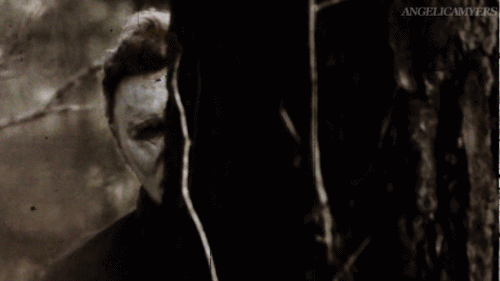
De contrabando - Jenny Rivera
Michael is a weird one. He is inconsistent and that song it's basically about a love like that. A love from time to time. Some days it's love and some days not. De vez en cuando.
"De contrabando". A forbidden love and of course it is like that. People cannot know that you and Michael are a thing.
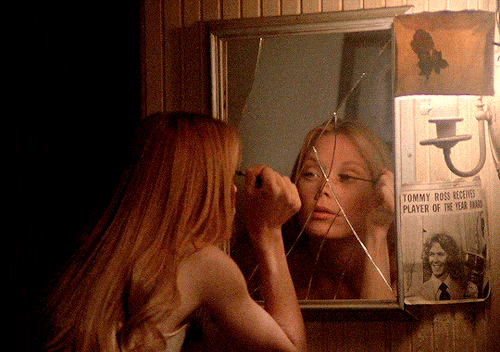
Háblame de ti - Banda MS
This one is about a man who wants to now everything about the woman he likes
Carrie doesn't have friends nor anyone who really listens to her so she really needs someone with the same enthusiasm that this song describes.

Siempre te voy a querer - Calibre 50
This one is about a love with it's ups and downs. As much as there is love there are also a lot of fights but even with the imperfections, you will always love him.

Me gusta todo de ti - Banda El Recodo
This is just what I felt since the first time I saw Daniel.
It's a song about simping. You like every physical trait, everything that person does to you.
"Esa forma tan dulce de hablarme" that sweet way of yours of talk me and you can't deny that his voice it's like honey (don't @me ik)
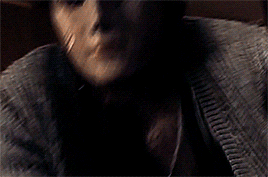
Hermosa Experiencia - Banda MS
Ok so I choose this one because is sexy. It's a sensual song about a man who appreciates the body of his girlfriend and for him it's a beautiful experience being with her. Touch her and worship her body.
And you can't tell me that Brahms isn't touch starved and into body worshiping.
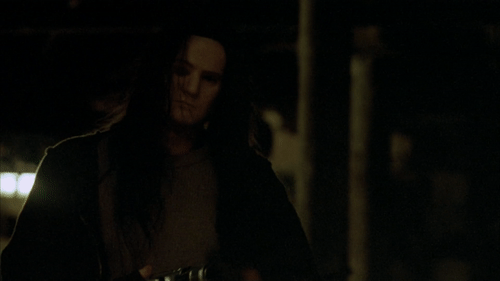
Te quiero así - Valentín Elizalde
This one is about a man putting his girlfriend at ease. She always focuses in her imperfections and the man is like "Yeah so, to me you are beautiful and I like you for being you, no matter what"

Piénsalo - Banda MS
This is about a man convincing a girl to be with him as he knows that the feeling is mutual, that he can give her serenades and gifts. That they're perfect for each other so she must think about it.
And I think that Tiffany would love to be treated that way.

Incomparable- Los Del Norteño Banda
This one is about someone that compares everything that is beautiful to the person they love but nothing comes closer to the beauty of them.
Like yeah, Bubba it's my beautiful being

Mi razón de ser - Banda MS
Honestly. I did this for him and this song.
He's just that beautiful to me and I really think that fits him perfectly.
If you can find the lyrics, please read it. It means "My reason of being" you know, the reason for you to keep living.
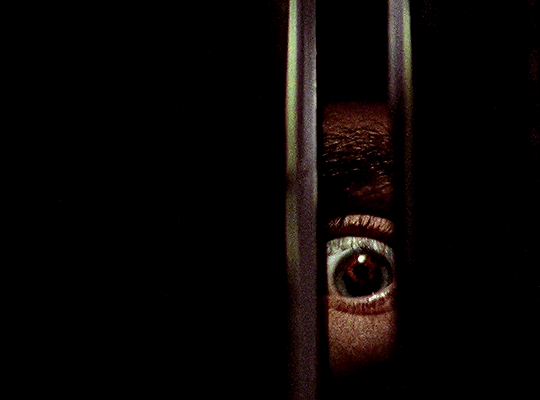
Mi sorpresa fuiste tu - Calibre 50
And last but not least. This one is about a man who realizes why every previous relationship was empty and irrelevant to him. Like it was destiny that the one was this person. A person that took them by surprise, one they could never tought they would love.
I think that's what happens in most of works about Billy and also what happened to me about him and his movie.
#slasher fandom#slashers#brahms heelshire#bubba sawyer#slasher headcanons#slasher x reader#carrie white#michael myers#tiffany valentine#bo sinclair#vincent sinclair#lester sinclair#candyman#billy lenz#mexican music#music#songs#mexican songs#Banda#dedicar canciones#idk
179 notes
·
View notes
Text
On Border Hauntology
“Ghosts or phantoms can mark the death of the ideas from the old world, as well as announcing a new principle of life.”
-Bruno Bosteels
The haunted dreamscape of the borderland unconscious comes to the surface in quematrasgos, the new release by experimental-electronic-Tejano duo Nudo. Listening to the seven tracks that make up the album, one feels as if they’re drifting across the histories of cultural lost futures, repressed political memories, and the communal desires that were once vibrantly alive along the US/Mexico border. Desires which manifested and materialized in multiple ways through the cultural expressions of the region.
By conjuring the sounds of corridos, norteño, and cumbia sonidera, the alien-like factory noises of the hellscape known as maquiladora city, as well as the vernacular folklore and jokes dealing with the violence permeating everyday life in the border, they effectively create a noise-sound-collage (in the style of Luigi Russolo’s Art of Noises) resembling the utopia of “hallucinatory visions in desperate times” described by Fredric Jameson in Archeologies of the Future. This striving for utopia evident in their futurist use of sampled regional music mixed with cosmic and weird sound effects (a practice originated in sonidero culture) places Nudo in the tendency of hauntology within the borderlands.
Hauntology as an aesthetic sensibility first emerged in Britain in order to deal with a cultural impasse defined by an inability to collectively imagine new futures at the so-called end of history. As the theorist Mark Fisher says, “the failure of the future is what defines hauntology more than anything.”
For Fisher, this ‘failure of the future’ had two interconnected effects: First, on a political level, it resulted in the loss of the radical imaginaries and aspirations launched by the revolutionary movements of the last century, by the students of ‘68, the anti-colonial struggle, and the movement for socialism that sprung across the Americas. Second, on an aesthetic level, electronic music ceased to be experimental and stopped pursuing the new, instead becoming mesmerized with the old forms and styles of times past. As Fisher argues, “by 2005, electronica was no longer capable of evoking a future that felt strange or dissonant.” These historic defeats suffered by emancipatory movements led us to an era “characterized by its inability to find aesthetic forms adequate to the present, still less to anticipate new socio-political futures.” (Jameson)
Hauntology represents an aesthetic response to the cancelation of the future, to the collective inability to think of a world radically different from our own, whether through music or our political imaginaries. Hauntological artists turn nostalgically towards the the past not in order to mourn and idealize it in relation to our present, but rather to actively reinterpret and remobilize half-forgotten cultural memories that promised alternative forms of futurity.
The ghosts, specters, and lost futures sought out by hauntology are emblematic of historical events that serve as reminders that capitalism is neither natural nor eternal, that there are other ways to organize society based on principles of solidarity and collectivity. They serve as aide-memoires of the times when struggles against capitalism, along with counter-cultures experimenting with new ways of being and seeing, were alive and ever-growing. Bruno Bosteels writes: “An event appears as a ghost both for what it no longer is and for what it has yet to be.” The aim of the hauntologist is to trace these ghosts haunting our present in order to reactivate the alternative futures “that have yet to be”.
To think about the nature of border hauntology, some questions arise: How does border hauntology deal with this failure of the future? What are the ghosts and lost futures haunting the borderlands today? What do the radical elements found in marginal cultural expressions tell us about the possibility to imagine alternative futures? What forms of futurity existed in the border which were foreclosed by capitalist forms of “progress”? Are there forms of a vernacular modernism found in border culture and art?
Nudo offers us an opportunity to deal with these questions as they take us across the simultaneously utopian and nightmare logic of the contemporary borderland unconscious. By way of a sonic dérive we trek alongside contemporary migrants-turned-psychogeographers stalking the ruins of a decaying civilization along the Rio Grande. T hey guide us through its sonic landscapes composed of cyber-sonideros, ghosts singing corridos, and cholombianos dancing chuntaro-style to deconstructed 3ball beats.
The mixing of traditional musical styles of the border with haunting soundscapes, which end up transforming the music into something alien and estranged, is characteristic of their aesthetic. This approach could be seen as serving a dual purpose: while the samples of corridos and sonideros function to invoke the lost futures they contain, the phantasmagoric sound effects layering the music allow for the return of the repressed histories of the region, namely the grinding conditions of life and work confronted by workers, farmers, migrant travelers, and so-called “illegal aliens”.
These repressed elements alluded to in the release point to the horrors capitalism requires to sustain and reproduce itself, requirements which are met in the margins of the system while perpetuating remnants of colonialism. Writing about the British colonization of India, Karl Marx touched on the reality of the borderlands of capitalism: “The profound hypocrisy and inherent barbarism of bourgeois civilization lies unveiled before our eyes, turning from its home, where it assumes respectable forms, to the colonies, where it goes naked.”
Doesn’t the brutality of labor experienced in maquiladoras, the never-ending work of immigrant farmers, the constant harassment and persecution of “illegal aliens” by the militarized border patrol, as well as the narco and State violence endured in everyday life, represent situations that reveal the truth, or essence, of capitalism? To paraphrase Marx, the inherent barbarism of capitalism is unveiled before our eyes at the US/Mexico border.
Border hauntology, then, can be seen as a means to invoke the ghosts of lost futures while creating a sonic phantasmagoria that brings to the surface the everyday violence - whether in the maquiladoras or the immigrant detention centers - visible in the borderlands. These repressed histories are explored aesthetically in quematrasgos along with a search for the traces of lost futures available to us in certain cultural expressions of the border. Expressions which are grounded in communal forms of enjoyment and other possible modernities, as is the case in the sonidero movement.
The specter of sonidero culture appears in the first two tracks of the release, FFA and roundUP (irrigated dessert). FFA submerges us into the distorted ambient soundscape of cyberspace while the pitched-down voice of a cyber-sonidero informs us he’s performing from a youtube streaming channel. The heavily eviscerated pop song serving as background noise resembles the pastiche mode hauntology seeks to transcend. The cyber-sonidero informs us we are also located in the borderlands by using expressions particular to the region (What the hell are we doing? Vamos a prender el bote!)
In roundUp (irrigated dessert), the cyber-sonidero drops a cumbia rebajada track (a style of mixing cumbia in which the music is pitched lower in order to create a haunting effect) while, like Virgil guiding Dante across the gates of hell and its labyrinthine structure, he announces our descent and crossing into the hellish side of the borderlands, into lo real: la frontera del alma, the real: the border of the soul. In the process, he recites its memories and spaces of terror over a cumbia rebajada:
“Dios. Maquiladoras. Angeles. Ciudad Juarez, Chihuahua. La Frontera. Eagle Pass, Texas. Lo Real. Estado. La Frontera del Alma. Tiempo. El Mezquite. Occurencia Vertical. El Paso del Águila. Estudio Esotérico. Estudio Prehispánico. Tormenta. Lo Verdadero, Lo Real, Lo Mítico. Desencarnado. Milagro. Dios del Charco. Dioses Castrados.”
“It is true that the old world belongs to the philistine. But one should not treat the latter as a ghost from which to recoil in fear. On the contrary, we ought to stare the ghosts in the eye!”
-Karl Marx
The sonidero culture invoked throughout the release point to the lost future being traced, offering an utopian vision in conflict with the underworld of the borderlands. Remnants of the sonidero movement still survive in the margins, whether amongst immigrant communities in the U.S. or in Tepito, albeit under constant attack by the repressive apparatuses of the State.
The futurist aesthetic and modernist ethos of sonideros are sometimes neglected by critics and musicologists. Sonideros are reduced to an exotic curiosity. They are viewed as traditional relics of some pastoral past, or as a form of resistance against the intrusion of western, or rather American, culture, due to their age-old Latin American and Caribbean music selection. In consequence, the potential futures they contain are ignored. Without a doubt, far from dealing with reality, these perspectives reflect the critics deep-rooted and erroneous belief that the modern and the new could never emerge from the margins of world capitalism.
Sonideros are better understood as modernist future rhythm machines that build bridges of solidarity within and across borders, while enforcing the right to the city. According to the musicologist Dario Blanco, “sonideros are heirs, upgraders, and transformers of a deep tradition of collective rituals.” In her essay Alternative Bodies on Streets, Cathy Raglan points to their transmodernist nature: “Sonideros present an idiosyncratic fusion of tradition and modernity in which the roots oriented sounds of rural vallenato-style cumbia are combined with the sonidero’s space-age sound effects.” Another feature they inherent from modernism is the strategy of turning the familiar strange and the strange familiar. As Cathy Raglan explains, “sonideros employ technology to alter their voice through filters, to alter the pitch, to create voices which are deep, grandiose and booming through the streets as if coming from another dimension.”
Ruben Lopez Cano, editor of Sonideros en las aceras, vengase la gozadera, writes about the sonideros approach to the city and public spaces: “The sonideros ability to close the street for public use makes people feel the power to partake in body expressions that deviate from the norm.”
These are some of the lost futures mourned and remobilized in border hauntology: the radicality of modernism, as well as the the right to the city and public spaces. These dreams and political aspirations can be traced through the actions and demands raised by the students of 1968. Describing the cultural effects of 1968 in Mexico, in his essay “The Melancholy Left”, Bruno Bosteels writes: “One of the lasting consequences of the events of 1968 consists precisely in displacing the borders of the political so as to include the everydayness - the infra-ordinariness, so to speak - of those who are the subjects of struggles for justice.”
By taking over the streets to create public spaces where joyous collective energies can emerge, where people can begin to sense what having control over our lives and cities could truly mean, sonideros remind us that alternative futures continue to exist in the margins, not only virtually but in concrete terms. As the surrealist poet Paul Eluard wrote, “there is another world but it is in this one.” The task is one of theorizing and acting in ways which expand such worlds which point towards a communist modernity.
In essence, the sonidero movement is a reverberation of modernism. In effect, the specters of modernism and its promise of the new are today roaming the margins of the so-called underdeveloped world, persisting in the aesthetic and political strategies of sonidero street culture. They allow us to contemplate an alternative modernity where technology and machines become means of creativity and joy rather than infernal machines of exploitation.
“Have you heard the cry of the dead?”
Doña Eduviges Dyada
Aside from the lost future of sonidero culture and its vernacular modernism there are other hauntings occurring in the borderlands. Sinister ghosts also appear in a region whose history has been defined by endless violence and necroeconomics. What does Nudo’s phantasmagoria of repressed border histories reveal? What forms do the central affects of hauntology, those of nostalgia and melancholia, manifest in the border?
Given the savagery and dispossession that continue to permeate the region, the other form of haunting that appears deals with the victims of the social horrors encountered in the region. It deals with the countless deaths of migrants risking their lives to cross over the Rio Grande, a space which today has been turned into a war-zone, as well as with the plague of femicides continuing to grow along border, or historical events like the massacres of students fighting for a better world, whether those of Tlatelolco in 1968 or Ayotzinapa in 2014.
These ghosts of these victims are spectrally present in the last track of the release, eCorrido. The track begins with a dubbed narco-corrido playing softly in the background, invoking the “war on drugs” and the senseless deaths of its 85 thousand victims (according to the dubious official figures of the government). A corrido begins playing amidst alien-like sci-fi effects insidiously dominating the atmosphere, while the singer struggles to be heard as he drifts into a cloud of impenetrable smog. The muffled singing leaves one wondering whose voice we are listening to and what message they are attempting to convey. The voice could very well be that of a ghost of one of the victims of narco wars, one of the massacred students of 1968, or a migrant that died under the brutal heat of the Arizona dessert, attempting to narrate the realities of Mexico’s repressed history. Throughout the corrido, they persist in their attempt to overpower the alien forces - symbolic of the maquiladoras, narcos, and corrupt politicians - that have taken over the border and our lives.
Border hauntology isn’t just dealing with lost futures, ghosts of by-gone eras, or with the “specter of a world that could be free.” The presence of ghosts belonging to contemporary history is precisely the result of the necropolitics shaping the lives of the oppressed in the border. As Bruno Bosteels writes in his study on “Politics, Psychoanalysis, and Religion in Times of Terror,” “In Latin America, ghosts don’t only appear to its inheritors; but also at the time of the events themselves.” The importance of present-day histories of violence to be heard in order to grasp the truths of capitalism explains the apparitions of these specters in border hauntology. The phantasmal voice in eCorrido is the voice of those being currently condemned to death by the logic of the system, voices demanding their presence in our collective imaginary. Put differently, in contrast to its British version, border hauntology goes beyond nostalgically mourning lost futures by dealing with the contemporary invisible ghost-like migrants that continue to die at the altar of capital accumulation.
The track Acequia also raises the question of giving voice to the dead whose histories uncover the systemic horrors surrounding us. On an aesthetic level, the track resembles Brian Eno’s Ambient 4: On Land in the way it shapes an ambience of simultaneously eerie and ethereal soundscapes composed of gentle guitar strums, distant voices that disappear as soon as they appear, along with, in the words of Mark Fisher, “a susurrating suggestion of nonorganic sentience”. What the sonic atmosphere of Acequia ultimately invokes through the incapacity of the impervious voices to express a single word, or the guitars to compose any kind of persistent melody, is a desire to give ontological presence to the uncomfortable dead.
The track is also reminiscent of Juan Rulfo’s Pedro Paramo, a novel which, like Nudo, employs the method of phantasmagoria to conjure the ghosts whose stories allow us access to the real of capitalism. The ambient soundscape riddled with glimpses of dead souls unable to narrate their stories found in Acequia feels very much like Juan Preciado’s experience as he descents into Rulfo’s Comala, a ghost town symbolic of the land of violence and death that is Mexico. Juan’s first encounter in Comala is with Doña Eduviges Dyada, who asks him: “Have you heard the cry of the dead?” As Juan continues wandering through the crumbling and deserted buildings of a by-gone era, unable to find a living soul, he suddenly feels the presence of ghosts attempting to speak all around him:
“I saw there was no one, although I kept hearing what sounded like the murmur of many people in a market. A constant buzz without rhyme or reason, similar to that which is made by the wind rustling the branches of a tree in the night, when neither the tree nor the branches can be seen though their whispers can be heard. I didn’t dare take another step. I began to feel that the murmuring was getting closer and circling me like a swarm until I was able to make out a few wards, almost void of sound: ‘Pray to God for us.’ That’s what I heard them telling me.”
This desire to give voice to the uncomfortable dead whose histories convey the realities of our world is essential to Nudo’s border hauntology. By invoking the ghosts of such necropolitical events of past and present in a sonic register, Nudo converts Gayatri Spivak’s question “Can the subaltern speak?” into “Can the dead speak?”
3 notes
·
View notes
Photo
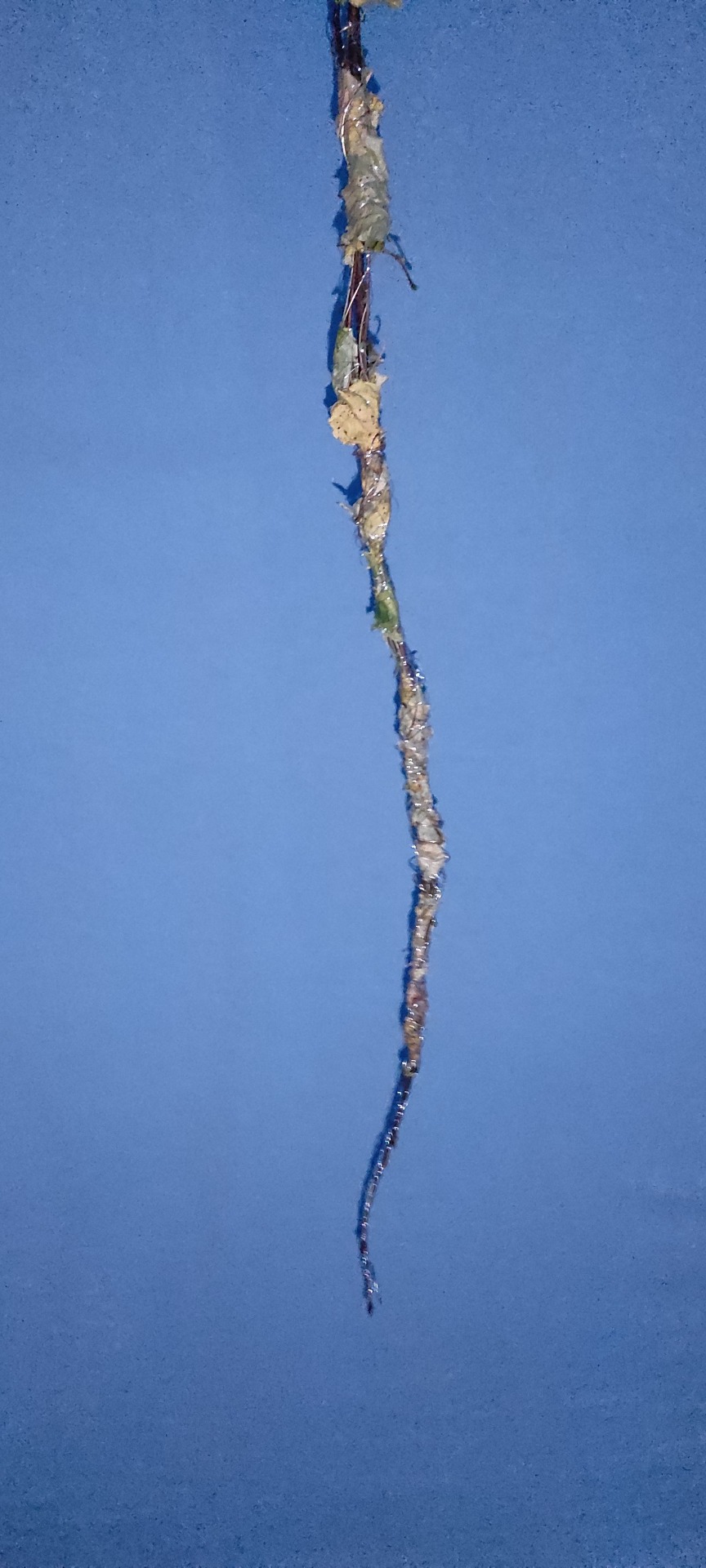
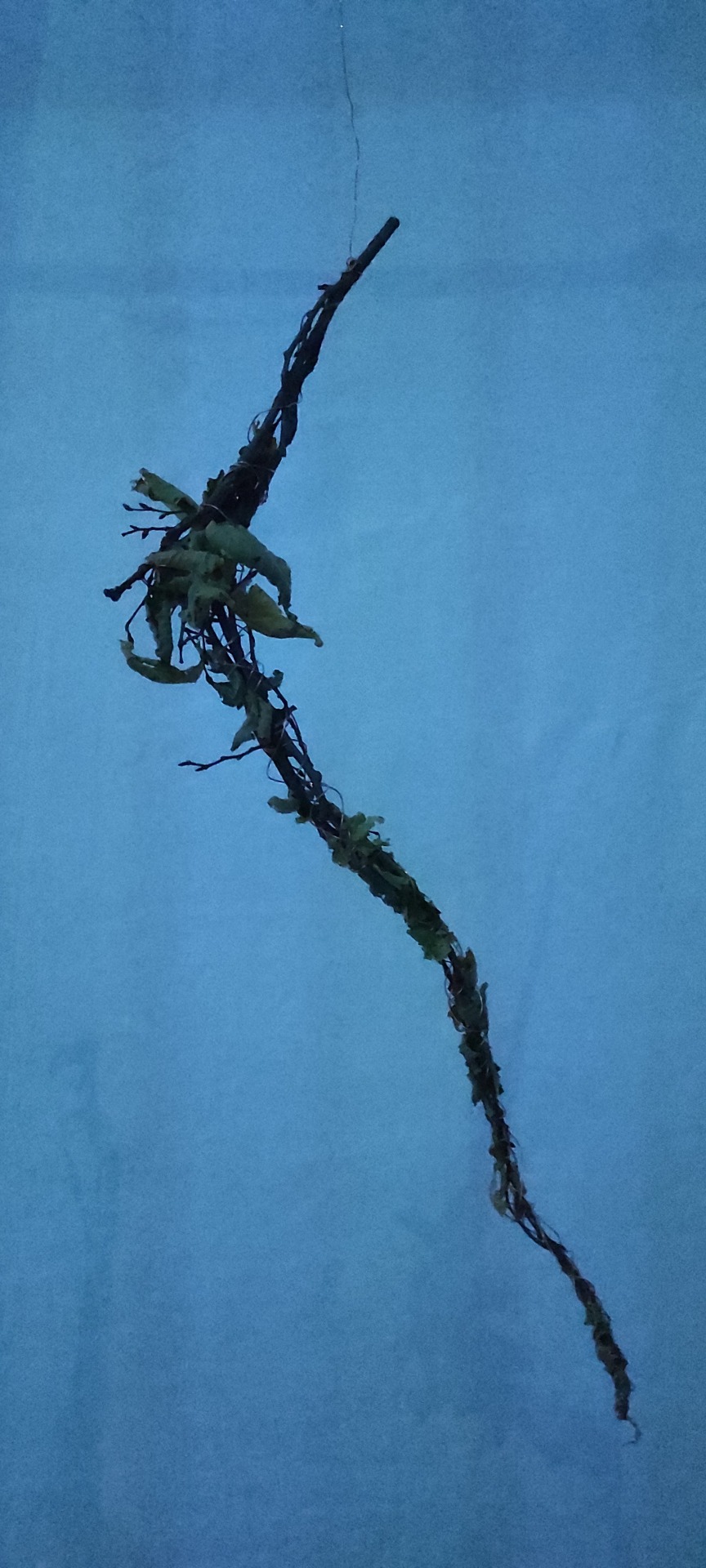
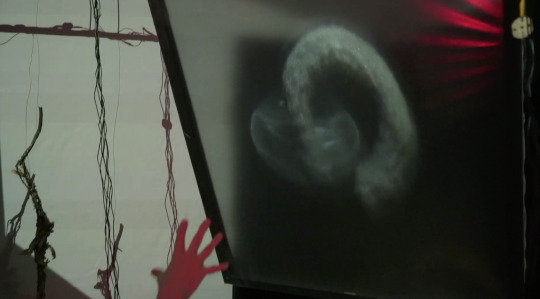
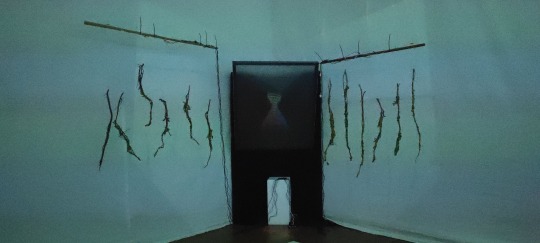
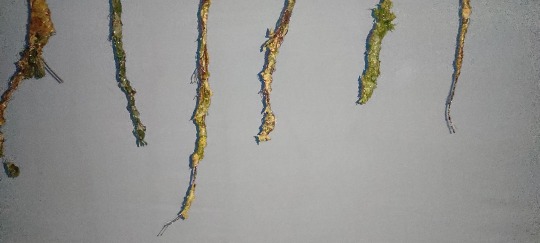
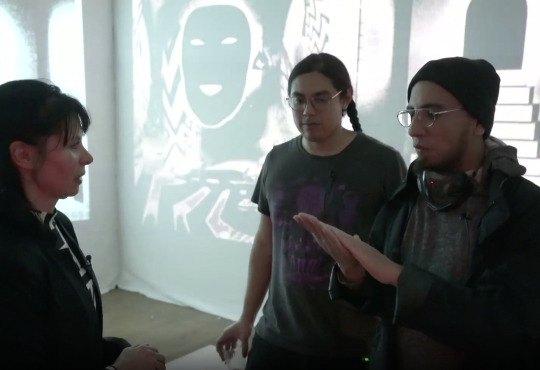
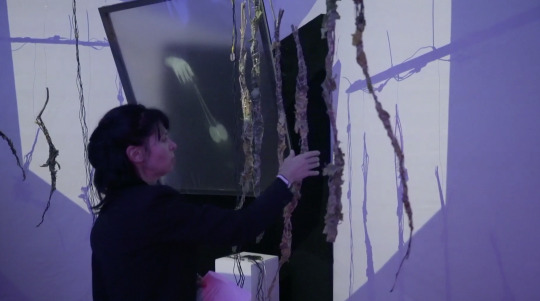
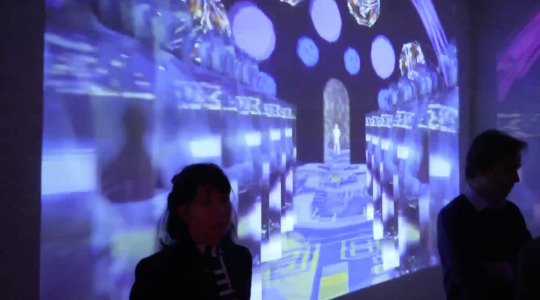

And I looked, and behold a white horse: and it projected that rebirth was coming, and beauty followed with it. And power was given unto them over the fourth dimension of the metaverse, to reboot with an avatar, and with desire, and with transformation, and with the unknown parallel dimension. Collaboration with Nathaniel Eras, Derek Holguin and Marjum Oskui for California Dreams Exhibition + Haydee Jimenez, Klaus Vom Bruch, Natalie Deseke, Benjamin Petersen. Interactive sound media with conductive materials, organic materials, and video hologram installation at Kuntsthalle Fause Hannover Germany 2021 View Video Here In a cooperation between KV Kunsthalle Hannover and the independent organization Nettnettradio based in Tijuana, Mexico and the independent artist group Lucid Interval based in L.A.. Mexican and Californian artists together with their German colleagues presented a spectrum of partly interactive media works and jointly developed strategies for their implementation and media presence.The starting point was the conceptual orientation of the project in the experiment to bring the Californian spirit of innovation, the mentality of its people in terms of internationality, openness and inventiveness to Hanover and to open up the potential of artistic interventions aimed at the future and utopia with the inclusion of digital technologies in discourse. Equally important was the strategy of networking between the partners to establish a common artistic platform in the Beuysian sense of a social sculpture. As a first result of the networking, the idea of implementing the project through an exhibition architecture consisting of several spherical, interlocking rooms to form a total work of art was already developed in the run-up to the exhibition in several Zoom conferences.
A series of freshly cut branches hanging down from a supporting structure, wrapped in copper wire and ultimately connected to a computer, act as receptors and form a transfer medium to the visitors, who can trigger a sound scenario by touching the branches.Thus, for example, temporally stretched tone sequences of an Accordion can be heard, which plays an important role in traditional Norteño Mexican music as well as in German folk music and also represents an analogy to digital tone modulation with regard to the physics of the elongated tone generation. The artist with Mexican roots himself makes another connection when he says: “the dying branches represent the arms of my ancestors”
The next step in achieving the goals was to closely coordinate the auditory components of the media works brought in or developed on site with an audiovisual center located within a white cube in the middle of the exhibition hall. There, visitors were able to send various sound patterns into the exhibition hall by touching suspended receptors in the form of branches, collected by the artist Nathaniel Eras, without acoustically interfering with the audiovisual works of other artists installed around the white cube. In reverse, the visual works of Derek Holguin and Nathaniel Eras were optically shielded within the white cube consisting of a double projection, an installation and a hologram. In this way, the white cube had a semi-permeable effect in both directions.
Acoustically attracted, curiously entering visitors were thus offered both a variable change of scenery and a place to linger, to hear, to see and to interact with the medium of sound.In order to create the greatest possible visibility for the project, a media (production) partner was involved, who installed centrally controllable still cameras in various parts of the exhibition, each directed at the artworks, and who captured different scenes by means of a steady cam that moved permanently through the exhibition. With the opening of the exhibition, the visitors also became part of the scenario, which then went online as a livestream.
Further art-mediating aspects were offered by the interviews, also broadcast as a livestream, which Natalie Deseke fromHanover conducted with her colleagues in the project and in this way was able to gather background information on the works and interesting facts about the participants. In this context, a live connection with Haydeé Jiménez from nettnettradio was also established and streamed on a monitor into the exhibition.In the course of the evening, Marjam Oskoui and the German-American duo Eras/Deseke presented live performances that captivated the audience visually and, in the latter case, acoustically as well. Using VR glasses and controllers in her hands, Oskoui showed large-scale 3-D painting projected onto the exhibition wall, the visualization processes of which, looped to become a permanent exhibition contribution, later also served as the background to the audio-visual performance by the duo Eras/Desecke.
Nathaniel Eras Lives and works in Berlin. Eras is a multidisciplinary artist, performer, composer and cultural catalyst who first established his career in Southern California. His current works focus on sound design for motion picture and futurist mysticism via performance art and ephemeral interactive art. The California born conceptual sound artist negates any notions of music genres, diving headfirst into deeper, esoteric soundscapes or incorporating elements by fusing emotive beauty with gritty industrial noises and field recordings. His complex interactive sound installation, developed in L.A..Nathaniel Eras processes different soundscapes of everyday life, which he has digitally reworked. Photo credit: Faust TV.
2 notes
·
View notes
Note
1 to 25 writers askss <3
1) is there a story you’re holding off on writing for some reason? I haven’t wrote anything about RoR because I have been feeling more... excited about other projects. I still want to finish it tho
2) what work of yours, if any, are you the most embarrassed about existing? The Origins, but probably because it was my first work for a fandom after 3 years of basically not sharing my writing with anyone. I still love it because that’s the work that made my friends notice me x’d
3) what order do you write in? front of book to back? chronological? favorite scenes first? something else? Depends. I’m currently working on two one shots, and I’m writing my favorite scenes of one of them first.
4) favorite character you’ve written Since this is a Renegades blog I’m going to take this question as if it was asking me about my favorite character to write about, and I’m going with Hugh and Simon *norteño emoji*
5) character you were most surprised to end up writing Tbh I never expected I end up writing about Ace and David, but here we are, and I love them.
6) something you would go back and change in your writing that it’s too late/complicated to change now I don’t think there’s anything I’d change. probably I’d make The Origins’ chapters longer JAJAJAJA
7) when asked, are you embarrassed or enthusiastic to tell people that you write? Depends x2
8) favorite genre to write Romance. But my favorite fanfic trope is Hurt/No-Comfort, does that count?
9) what, if anything, do you do for inspiration? Listen to music. Almost all my fics are based off songs.
10) write in silence or with background noise? with people or alone? Silence and alone, like a mamoncita.
11) what aspect of your writing do you think has most improved since you started writing? I think I’ve improved a lot with my sentence structure:)
12) your weaknesses as an author Physical fight scenes and scenes where I have to give explanations
13) your strengths as an author Verbal fight scenes and... I want to think that comedy is also a big strength of mine *le pegan por payasa*
14) do you make playlists for your current wips? Only RoR has a playlist, but I do have a lot of songs for my current wips. Some of them without context are:
Todavía - Matisse
Death of a Hero - Alec Benjamin
Through your eyes - Alec Benjamin
Just Like you - Alec Benjamin
Demons - Alec Benjamin
From Now On - The Greatest Showman
Cómo te extraño, Mi Amor - Leo Dan
Canción Sin Miedo
As you can see I love Alec Benjamin lol
15) why did you start writing? I fully believe it had to be with the fact that I wanted to... understand certain things that happened to me when I was a kid.
16) are there any characters who haunt you? wey no mames el wero pendejo lteralmente me persigue en mis sueños hijo de su chingada madre ojalá coma pito y se ahogue
17) if you could give your fledgling author self any advice, what would it be? Keep writing.
18) were there any works you read that affected you so much that it influenced your writing style? what were they? Insignia Series and... ngl probably Rainbow Rowell. I’m sorry. Rainbow Rowell is... not a nice person x’d
19) when it comes to more complicated narratives, how do you keep track of outlines, characters, development, timeline, ect.? Yes, I do!
20) do you write in long sit-down sessions or in little spurts? Lately I’ve been writing in very little spurts because of my current housing situation
21) what do you think when you read over your older work? “Ay Obsi you sweet thing there’s not a single thought inside that head isn’t it?”
22) are there any subjects that make you uncomfortable to write? The only thing I’m uncomfortable writing is hardcore smut. Other than that, I’m fine
23) any obscure life experiences that you feel have helped your writing? my childhood trauma definitely the most toxic parts of the relationships I have with the members of my family. I think... it makes me take a neutral position on characters I like and being neutral is pretty important for me when it comes to writing, especially because of the topics I like to write about.
24) have you ever become an expert on something you previously knew nothing about, in order to better a scene or a story? No, I’m not that smart JAJAJAJA
25) copy/paste a few sentences or a short paragraph that you’re particularly proud of Right now I’m on an edgy state of mind so I’m going to leave this question unanswered *emoji norteño x2*
3 notes
·
View notes
Text
Host Your Dream Event with El Gordo’s Catering Services in Union

Planning an unforgettable event starts with exceptional food. At El Gordo Peruvian Eatery, we understand the power of delicious cuisine in bringing people together and creating memorable experiences. With our catering services in Union, NJ, we bring the vibrant flavors of Peru straight to your special occasions. Whether it’s a wedding, birthday celebration, corporate gathering, or a family reunion, El Gordo is here to elevate your event with our expertly crafted dishes.
Authentic Peruvian Cuisine Delivered to Your Doorstep
El Gordo’s catering services are built on the foundation of authentic Peruvian culinary traditions. Our menu features a rich array of dishes that highlight the diverse and flavorful heritage of Peru. From the savory spices of Pollo a la Brasa (our signature rotisserie chicken) to the comforting flavors of Arroz con Pollo and the tangy allure of Papa Rellena, every dish is meticulously prepared to delight your guests.
With El Gordo, you don’t have to settle for generic catering options. Instead, treat your guests to a culinary journey through Peru, right here in Union.
Convenient and Flexible Catering Options
We know that hosting an event comes with its fair share of logistics and planning. To make things easier for you, El Gordo offers flexible catering services designed to fit your needs. You can opt to:
Pick-Up Your Order: Conveniently collect your catering order from our Union location and bring it straight to your venue.
Get It Delivered: We’ll deliver freshly prepared dishes to your doorstep, ensuring they arrive hot and ready to serve.
While we do not provide event setup or management, our focus remains on delivering top-notch Peruvian cuisine that will be the highlight of your event.
Perfect for Any Occasion
El Gordo’s catering services are versatile and suitable for a variety of events. No matter the size or type of gathering, our team works with you to craft a menu that suits your occasion.
Here are just a few events we cater to in Union:
Weddings: Celebrate your big day with an array of dishes that reflect your unique taste.
Corporate Events: Impress colleagues and clients with our flavorful, high-quality Peruvian offerings.
Birthdays and Anniversaries: Make your milestones extra special with dishes that your guests will rave about.
Family Reunions: Bring your loved ones together over a shared love for great food.
Community Gatherings: Infuse cultural celebrations with the vibrant tastes of Peru.
Signature Dishes That Steal the Show
Our catering menu features crowd-pleasing favorites that guarantee to impress. Some of our most popular dishes include:
Pollo a la Brasa: Juicy, flavorful rotisserie chicken seasoned with authentic Peruvian spices.
Papa Rellena: Crispy mashed potato stuffed with savory fillings for a delightful appetizer.
Seco Norteño: A traditional lamb stew that’s rich, hearty, and perfect for formal events.
Chaufa de Mariscos: A seafood fried rice infused with bold Peruvian flavors.
Pair these with our traditional beverages, such as Chicha Morada (a refreshing purple corn drink) or Inca Kola, to offer your guests a true taste of Peru.
Why Choose El Gordo for Your Catering Needs?
When you choose El Gordo Peruvian Eatery for your catering services, you’re not just getting food—you’re getting an experience. Here’s why we’re the preferred choice in Union, NJ:
Authenticity: Our dishes are crafted using traditional Peruvian recipes, ensuring every bite is bursting with genuine flavor.
Quality Ingredients: We use only the freshest, highest-quality ingredients to prepare our meals.
Customization: Our team works with you to create a menu that fits your event and your guests’ preferences.
Reliability: Whether you pick up your order or opt for delivery, we ensure everything is prepared on time and to perfection.
Plan Your Dream Event with El Gordo
Hosting an event in Union doesn’t have to be stressful. With El Gordo’s catering services, you can focus on enjoying your special day while we handle the food. Our team is dedicated to providing exceptional cuisine that leaves a lasting impression on your guests.
Let El Gordo Peruvian Eatery be part of your next celebration. Whether it’s an intimate gathering or a grand occasion, our catering services are here to make your event extraordinary.
Contact us today to place your catering order and bring the rich, vibrant flavors of Peru to your table. At El Gordo, we’re more than just food—we’re a celebration of culture, taste, and together
0 notes